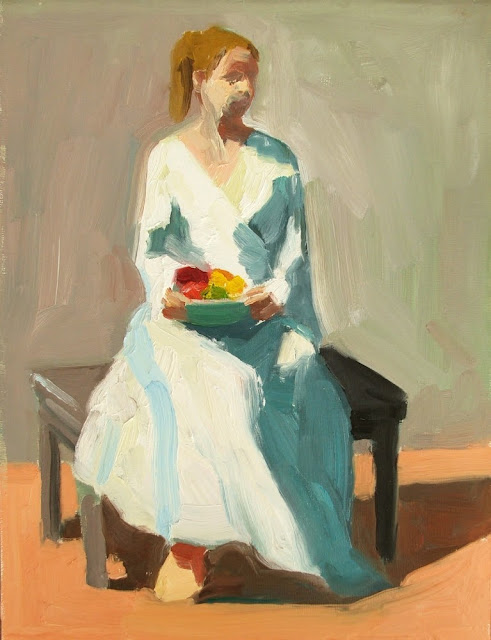Here's her palette. She squeezes out quite a bit of paint even for a small study, something else I'm trying to do more.
Here's the demo. First step is a line drawing of the form, keeping in mind the proportions of the body. Indicate the light and shadow areas with line, then fill in with your two colors.
Your computer monitor may show those two colors as being different values, but in person, they were absolutely equal. This subject worked very well with the cool "light" and warm "shadow", and the equal values created a nice visual vibration.
Here is one of my studies (left) using equal values (warm light/cool shadow) and a board of more examples that Peggi brought. The lower right image is just two values for the figure and background. These are wonderful exercises to practice drawing, modeling the form, and creating a value plan while trying any color combinations that you're wondering about.
A painting friend of mine, Kathryn Townsend, took a workshop with Peggi last summer (see her blog entries about that here). She said that Peggi mentioned a technique she had used for a year to help maintain coherent value families: she drew a line down the middle of her palette and mixed only "light family" colors on one side, and "shadow family" colors on the other. I asked Peggi about that the first day, and she said absolutely yes, that's very helpful. She painted a line down the middle of my palette, and I left it there. I painted that way for the rest of the workshop, and it helped me SO much to keep my values right. It's been a very bad habit of mine to mix my colors all over the palette, wherever there's room. Now, that separation on the palette is becoming automatic, and the paintings benefit from it because the value groups are much better-defined.
We talked about modeling the form, and the difference between form shadow vs. cast shadow. Form shadow is created as the form turns away from the light. It is a softer-edged shadow, usually transitioning through a half tone between the light and the shadow areas. A cast shadow, on the contrary, can be very hard-edged.
We did two paintings from the models, again these were 40-minute sessions, and again there were fairly well-defined value families, simplified and consolidated. This time we paid more attention to form shadow vs. cast shadow, using half tones where the form turned, and again trying to use color instead of value to define shapes within each value family.
12" X 9", oil/panel.
For the final painting session of the workshop, we did the celebrated "Limited Strokes" exercise. I was looking forward to this one. It's such a wonderful way to loosen up, pile on the paint, and surprise yourself.
Here's Peggi's demo. Start with a line drawing, mix vast piles of color on your palette, and then create a painting with as few strokes as possible.
An entire area of background can be done with one stroke, but you have to really load the brush. No back and forth, no scrubbing. The brush must move forward at all times, but you can roll it over to double back and continue filling in an area. Each completed stroke is tallied by putting a dab next to the painting, so you don't lose count. Peggi had the one above finished in less than 20 strokes, but added a few more touches to put in the features of the face and folds on the beach towel. Here are two other example paintings that Peggi brought. You can count the "dabs" and see that it took her very few strokes to complete these lovely works:
As Peggi says, this exercise helps you think about mixing enough paint to cover the area you plan to cover, and gets you to really load your brush. You get a result that's supremely painterly and not overworked. Even if this is not how you want to paint all the time, this exercise will stretch some painting "muscles."
And now, a shameless plug for Peggi's set of DVDs. The limited stroke exercise is one of the lessons, and the value work that we did is covered on others. They aren't a substitute for taking a workshop with her (which I totally recommend that you do), but they're a great (and inexpensive) way to make solid improvement in your painting, no matter what your style is.
A few closing thoughts from Peggi:
Don't gray down the flesh tones in shadow. Even in shadow, flesh is full of color.
Remember that you're making a painting, telling a story! You're not required to slavishly record local color if you can enhance the painting with some colorful innovation. Make marks, use accent colors, make it sing!
Use your two secret weapons. Pocket mirror and sketchbook!
And most importantly, keep painting. :)







